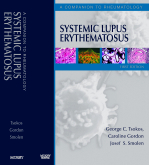|
|
|
| |
 |
|
|

|
 推薦指數:
推薦指數:





|
|
- 內容介紹
|
Systemic Lupus Erythematosus - A Companion to Rheumatology
By George C. Tsokos, Caroline Gordon and Josef S. Smolen, MD
608 pages 300 ills
Trim size 7 1/4 X 10 1/4 in
Copyright 2007
Description
This new companion to Hochberg et al.'s Rheumatology masterwork provides new insights into the causes, detection and therapy of this challenging disease. In this state-of-the-art resource, you’ll find ‘one stop’ coverage of all the latest scientific and clinical developments in SLE: new concepts in epidemiology, disease activity measures and outcomes; new concepts in immunoregulation, genetic and pathogenic mechanisms; new understanding and novel presentation of the processes of tissue/organ damage; comprehensive coverage of clinical features; and the very latest concepts in treatment.
Reviews
REVIEW OF THE PARENT VOLUME: "Rejoice! The third edition of this outstanding reference work is here…Rheumatology covers all the bases and is the single text one should own if there is a limit on shelf space and budget…A remarkable accomplishment, notable for its comprehensiveness as well as its wisdom." (JAMA)
Key Features
Provides the very latest understanding of the pathogenesis of SLE.
Distills current understanding of the cellular, molecular, genetic and environmental factors that instigate and drive the disease.
Includes comprehensive coverage of clinical features, including fatigue, organ system manifestations, overlap syndromes, infections, and more.
Conveys the very latest understanding of mechanisms of tissue damage, including immune complexes, antibodies, and other mechanisms that lead to organ damage.
Contains expert discussion of processes that are responsible for tissue injury – a hallmark of this text.
Incorporates the latest treatment modalities, including steroids and non-steroidals, cytotoxic drug treatment, PAP’s, and therapies on the horizon.
Discusses the latest treatment options on disease modifying or disease controlling agents.
Table of Contents
Epidemiology and Diagnosis
1. Epidemiology
2. Disease Activity Measures
3. Disease Outcome
4. Quality of Life and Economic Aspects
Pathogenesis
1. Overview of the Pathogenesis of SLE
2. Genetics
3. Hormones
4. Immunoregulation – T Cells, B cells, and cytokines.
5. Cell Surface Receptors ostimulation/BAFF/FcgR/TLRs)
6. Dendritic Cells
7. Apoptosis
8. Structure and Origin of Autoantibodies
9. Animal Models
10. Genetics of murine lupus
11. Infection and autoimmunity
Mechanisms of Tissue Damage
1. Complement
2. Immune complexes
3. Antibodies
a. ANA and standardization of antibody techniques
b. Anti-DNA
c. Anti-splicesomosal ab
d. Anti-Ro/La
e. Anti-Histone
f. APL
g. Anti-neuronal
4. PMNs
5. Mechanisms of renal damage
6. Mechanisms of vascular damage
7. Nitric Oxide
Clinical Aspects of the Disease
1. Constitutional Symptoms and Fatigue
2. Skin
3. Kidney
4. Heart
5. Lung
6. GI/liver/pancreas
7. Infections
8. Blood (anti-phospholipid syndrome)
9. Nervous System
10. Overlap Syndromes
11. Ophthalmic Manifestations
12. Pregnancy
13. Fertility
14. Neo-natal lupus
15. Hereditary and Malignant Lupus-like Diseases
Treatment of the Disease
1. Non-Steroidals – Anti-Malarials and Statins
2. Steroid Treatment
3. Cytotoxic Drug Treatment including M.M.F
4. PAPS
5. New Treatments
|
|
|

